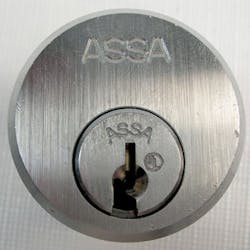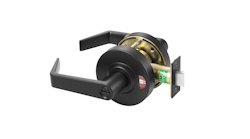ASSA introduced the Twin 6000 High Security lock mechanism into the United States in 1984, offering a UL437 retrofit lock cylinder that provided patent protection against unauthorized key duplication. Since then, ASSA has continuously improved their patented lock mechanisms. The ASSA Twin series lock mechanisms feature two independent locking technologies operated by one key. A standard nine depth, six space pin tumbler lock mechanism is operated by depths cut into the top of the key blade. The second consists of five side cut positions with five depths into the lower shelf portion of the left side of the key blade operates a coded sidebar.
The Twin 6000 series was made available using four programs that controlled the availability of key profiles by creating areas of exclusivity. Various sidebar codes are used to create different keyways.
The basic program provided local exclusive keyways for locksmiths. The next program level provided regional exclusive keyways for locksmiths. The third level provided national exclusive keyways for distributors. And the highest level provided regional and national exclusive keyways for end users, sold through normal distribution channels.
In 1996, ASSA introduced the patented Twin V-10 system, the next version of ASSA patented Twin Series lock mechanisms. The patent covers both the key and the lock cylinder. The Twin V-10 series was introduced as the next upgrade to the expiring patents of the ASSA Twin 6000 series. The patented features of the Twin V-10 include the under cut surface behind the side cut on the key blank, on a new key blank profile, and new side pins. Twin V-10 keys have "V-10" embossed into the bow.
The Twin 6000 and Twin V-10 components are not interchangeable.
In May 2000, ASSA introduced the Twin Exclusive. With V-10 patented features using the Twin 6000, 51 profile, it became the direct upgrade, offering Twin patented protection from unauthorized key duplication and backward compatibility to the Twin 6000 series. The Twin Exclusive improvements included milled undercut surface behind the side pin shelf and new broach opening of the lock cylinder plug. The Twin Exclusive keys can be identified by the undercut on the key along the inner surface of the blade.
The Twin 6000, Twin V-10, and Twin Exclusive were designed to be serviced by locksmiths.
In 2003, ASSA introduced the Twin Pro series, making the locks only available to ASSA end users and ASSA Certified Service Centers. The Twin Pro cylinders are not stocked through traditional distribution. The Twin Pro mechanical lock mechanism can interface with the ASSA Cliq system. The electronics-based Cliq offers key accountability with access control.
The ASSA Twin Series lock mechanisms are designed for single step master keying. The KIK/KIL, mortise and rim are equipped with six bottom pin sets that are manufactured of nickel silver. The longest bottom pin is a number #1 and the shortest pin is a #9. All of the pins are 0.114" in diameter. The design of the bottom pin is tapered to a flat that is 0.020" in diameter to provide a more reliable contact between the tumbler and the flat of the key cut. There are eight master pin lengths beginning with the shortest being #1 to the longest being #8.
ASSA Twin series lock cylinders use four graduated spooled top pins lettered A, B, C & D according to the operating pin stack.
Note: The KIK/KIL lock cylinders whose cylinder height is 1.020" require a modified pin stack by downsizing the top pins by one increment, according to the operating pin stack. The "A" top pin is downsized to a #5 master pin.
There are five side pins in every ASSA Twin Cylinder. There are five depths for each of the five side pin positions, providing in excess of 2,800 side codes. The side codes individualize the keyways. Each sidebar is reversible. Each sidebar is assigned two side codes that are obverse and reverse side codes. For example, a side code of 1-2-3-4-5 would have an obverse side code of 5-4-3-2-1.
Differences between Twin 6000/Exclusive, the V-10, and the Pro are identifiable. From the exterior, the Twin V-10 can be identified by the V-10 stamped into the face of the plug. Only the ASSA name is stamped into the plug face for the Twin 6000 and Twin Exclusive. Internally a "V" shaped portion of the Twin V-10, Twin Exclusive and Twin Pro plug shows above the side pin area.
The Twin 6000 and Twin Exclusive have one style of side pin looking like top pins with false gates for pick resistance above and below the opening gate. As the proper key is inserted into the lock cylinder, the side cuts raise the side pins to the proper height to accommodate the coded sidebar fence positions into the opening gate of each of the five side pins.
The Twin V-10 has left and right hand side pins with eccentric shapes. These pins are mirror images of each other. By having left and right hand side pins, the ASSA V-10 series is capable of multiplex system design. They have false side gates above and below the side pin opening gate. As the key is inserted, the side pins are lifted from the bottom surface similar to a Twin 6000 and Exclusive pin. These handed pins must lift up to the proper position to accommodate the coded sidebar.
The Twin Pro has one type of eccentric shape side pin having false side gates above and below the side pin opening gate. This side pin is not interchangeable with the V-10 side pins. As the key is inserted, the side pins are lifted at the back of the pin at a location called the centering tab.
Twin Series keys and the sidebars are machined at the factory for each side code combination. If the side code combination of the key and the sidebar match, then the sidebar will retract into the cylinder plug.
Recombinating An ASSA Twin Exclusive Mortise Cylinder
The ASSA Twin lock cylinders can be recombinated using two different operations. The first operation is to reverse the sidebar. This will either change the primary side of the sidebar to the secondary side. Or change the secondary side of the sidebar to the primary side. Changing the sidebar requires changing the keys to using the ones equipped with compatible side cuts to the changed sidebar.
For the purpose of this article, we will recombinate an ASSA Twin Exclusive mortise cylinder by inverting and reversing the sidebar:
Step 1. Remove the two Phillips head screws securing the cam onto the plug of the mortise cylinder.
Step 2. Insert an operating key into the lock cylinder. Rotate the plug approximately 30 degrees to misalign the pin chambers.
Step 3. Place a 0.500" diameter plug follower with a hollowed end for 1 1/8" mortise cylinders against the rear end of the plug and carefully slide the plug out of the housing. As the plug slides out of the housing, make certain the sidebar and sidebar springs do not fall out.
Step 4. Once the plug has been removed from the housing, carefully remove and reverse the sidebar component by turning 180 degrees, and place the sidebar into the slot in the plug on top of the sidebar springs. The sidebar will not press completely into the body of the plug, as the side cut in the key will not place the side pins in the proper location for the new side configuration.
IMPORTANT: Any time the plug is outside of the cylinder housing, do not remove the key.
Step 5. Align the sidebar with the sidebar slot in the cylinder housing.
Step 6. Slide the plug into the cylinder housing.
Step 7. Remove the key.
Step 8. Insert the key with the proper side cuts (keyway). Check the operation of the lock mechanism.
Step 9. Install the cam and the two Phillips Head screws. Check the operation of the lock mechanism.
Recombinating Bottom Pins
To recombinate a Twin 6000 mortise cylinder bottom pins, ASSA recommends removing the spring retainer.
Step 1. Hold the mortise cylinder with the spring retainer at the 12 o'clock position.
Step 2. With no key inserted into the lock cylinder, slowly slide the spring retainer out of the slot. Be careful not to loose any of the springs as they expand.
Step 3. Empty the pin chambers.
Step 4. Combinate the lock cylinder using new tumbler pins.
Step 5. Load the springs into the pin chambers.
Step 6. While holding the lock cylinder, compress the springs into the pin chambers with your finger.
Step 7. Insert an operating key. Test the operation of the lock cylinder.
Step 8. While compressing the springs, carefully install the spring retainer. Test the operation of the lock cylinder.
Once the lock cylinders have been serviced, ASSA recommends using approved lubricant twice a year as part of normal maintenance.
For more information, contact your local locksmith wholesaler or ASSA Inc., 110 Sargent Drive, New Haven, CT 06534-0453. Telephone: 800-235-7482. Web site: www.assalock.com. Fax: 800-0892-3256.






